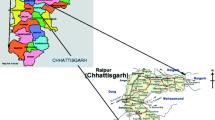Abstract
This paper, the second in the series, verifies the entropy-based univariate model developed in the first paper for long-term streamflow forecasting on five rivers from different regions of the world. The results of the model are compared with the corresponding results of ARIMA and state-space model. The Lagrange multipliers of the univariate model are found similar to autocorrelation coefficients of the ARIMA model. Forecasts by ARIMA and univariate models were comparable for periodic streamflow, but for forecasting of highly variable streamflows the univariate model was superior.
Similar content being viewed by others
References
Akaike, H. 1976: Canonical correlation analysis of time series and the use of an information criterion. In: Mehra, R.; Lainiotis, D.G. (eds.) Advances and case studies in system identification, pp. 27–96, New York: Academic Press
Anderson, R.L.: 1941: Distribution of the serial correlation coefficients. Annals of Mathematical Statistics 8(1), 1–13
Box, G.E.P.; Jenkins, G. 1976: Time series analysis, forecasting and control, 2nd edition. San Francisco, California: Holden Day
Bras, R.L.; Rodriguez-Iturbe, I. 1985: Random functions and hydrology. Reading, Massachusetts: Addison-Wesley Publishing Company
Burg, J.P. 1975: Maximum entropy spectral analysis. Ph.D. Thesis, Standford University, 123p., Palo Alto, California, University Microfilims, pp. 75–25, 499.
Grandell, J.; Hamrud, M.; Toll, P. 1980: A remark on the correspondence between the maximum entropy method and the autoregressive model. IEEE Transactions Information Theory IT-26, 750–751
Haykin, S. S. (ed.) 1979: Nonlinear methods of spectral analysis. Topics in Applied Physics, Vol. 34, New York: Springer-Verlag
Jain, D.; Singh, V.P. 1986: A comparison of transformation methods for flood frequency analysis. Water Resources Bulletin 22 (6), 903–912
Jaynes, E.T. 1982: On the rationale of maximum entropy methods. Proceedings of IEEE 70 (9), 939–952
Kumar, A.; Chander, S. 1985: Long-term forecasting model. In: Proceedings of IWOAM, pp. 307–320, Indian Institute of Technology, Delhi, India
Priestely, M.B. 1980: System identification, Kalman filtering and stochastic control. In: Brilinger, D.R.; Kiao, G.C. (eds.) Directions in time series, pp. 188–218, Institute of Mathematical Statistics
Priestley, M.B. 1981: Spectral analysis and time series, Vol. 1–2. London, U.K.: Academic Press
Salas, J.D.; Delleur, J.W.; Yevjevich, V.; Lane, W.L. 1980: Applied modeling of hydrologic time series. Water Resources Publications, Littleton, Colorado
Sancholuz, A.; Carrasqual, S.; Vargas, D. 1981: Modelos matematicos para la prediccion de niveles del Rio Orinoco. Caracas, Venezuela, Laboratorio Nacional de Hidraulica Ernesto Leon D.
USGS. 1986: Water resources data—Louisiana, water year, 1986. U.S. Geological Survey Water-Data Report LA-86-1, Baton Rouge, Louisiana
Van den Boss, A. 1971: Alternative interpretation of maximum entropy spectral analysis. IEEE Transactions on Information Theory IT-17, 493–494
Vecchia, A.V. 1985: Periodic autoregressive-moving average (PARMA) modeling with applications to water resources. Water Resources Bulletin 21 (5), 721–730
World Meteorlogical Organization (WMO), 1975: Intercomparison of conceptual models used in operational hydrologic forecasting. Operational Hydrology Report No. 7, Secretariat of WMO, Geneve, Switzerland
Young, P.C. 1984: Recursive estimation and time series analysis—an introduction. Berlin and Heidelberg: Springer Verlag
Author information
Authors and Affiliations
Rights and permissions
About this article
Cite this article
Krstanovic, P.F., Singh, V.P. A univariate model for long-term streamflow forecasting. Stochastic Hydrol Hydraul 5, 189–205 (1991). https://doi.org/10.1007/BF01544057
Accepted:
Issue Date:
DOI: https://doi.org/10.1007/BF01544057




